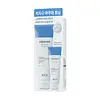What's inside
What's inside
 Key Ingredients
Key Ingredients

 Benefits
Benefits

 Concerns
Concerns

No concerns
 Ingredients Side-by-side
Ingredients Side-by-side

Water
Skin ConditioningCellulose
AbsorbentGlycerin
HumectantPropanediol
SolventButylene Glycol
Humectant1,2-Hexanediol
Skin ConditioningBetaine
HumectantSaccharide Isomerate
HumectantTromethamine
BufferingCarbomer
Emulsion StabilisingAcrylates/C10-30 Alkyl Acrylate Crosspolymer
Emulsion StabilisingPolyacrylate Crosspolymer-6
Emulsion StabilisingC12-14 Pareth-12
EmulsifyingEthylhexylglycerin
Skin ConditioningGlyceryl Acrylate/Acrylic Acid Copolymer
HumectantDisodium EDTA
Sodium Citrate
BufferingCitric Acid
BufferingCaprylic/Capric Triglyceride
MaskingCeramide NP
Skin ConditioningHydrogenated Lecithin
EmulsifyingNiacinamide
SmoothingGluconolactone
Skin ConditioningAscorbyl Glucoside
AntioxidantButene
Xylitylglucoside
HumectantAnhydroxylitol
HumectantTocopherol
AntioxidantXylitol
HumectantHydrolyzed Collagen
EmollientWater, Cellulose, Glycerin, Propanediol, Butylene Glycol, 1,2-Hexanediol, Betaine, Saccharide Isomerate, Tromethamine, Carbomer, Acrylates/C10-30 Alkyl Acrylate Crosspolymer, Polyacrylate Crosspolymer-6, C12-14 Pareth-12, Ethylhexylglycerin, Glyceryl Acrylate/Acrylic Acid Copolymer, Disodium EDTA, Sodium Citrate, Citric Acid, Caprylic/Capric Triglyceride, Ceramide NP, Hydrogenated Lecithin, Niacinamide, Gluconolactone, Ascorbyl Glucoside, Butene, Xylitylglucoside, Anhydroxylitol, Tocopherol, Xylitol, Hydrolyzed Collagen
Water
Skin ConditioningQuaternium-60
Propylene Glycol
HumectantCarbomer
Emulsion Stabilising1,2-Hexanediol
Skin ConditioningCarica Papaya Fruit Extract
Skin ConditioningCitric Acid
BufferingScutellaria Baicalensis Root Extract
AstringentGlycyrrhiza Glabra Root Extract
BleachingSodium Hyaluronate
HumectantHydroxyethyl Urea
HumectantCeramide NP
Skin ConditioningCentella Asiatica Extract
CleansingMelaleuca Alternifolia Leaf Extract
PerfumingAllantoin
Skin ConditioningBetaine Salicylate
AntimicrobialOctyldodecanol
EmollientPolygonum Cuspidatum Root Extract
AntioxidantCamellia Sinensis Leaf Extract
AntimicrobialRosmarinus Officinalis Leaf Extract
AntimicrobialChamomilla Recutita Flower Extract
MaskingPentylene Glycol
Skin ConditioningButylene Glycol
HumectantCaprylyl Glycol
EmollientDisodium EDTA
Water, Quaternium-60, Propylene Glycol, Carbomer, 1,2-Hexanediol, Carica Papaya Fruit Extract, Citric Acid, Scutellaria Baicalensis Root Extract, Glycyrrhiza Glabra Root Extract, Sodium Hyaluronate, Hydroxyethyl Urea, Ceramide NP, Centella Asiatica Extract, Melaleuca Alternifolia Leaf Extract, Allantoin, Betaine Salicylate, Octyldodecanol, Polygonum Cuspidatum Root Extract, Camellia Sinensis Leaf Extract, Rosmarinus Officinalis Leaf Extract, Chamomilla Recutita Flower Extract, Pentylene Glycol, Butylene Glycol, Caprylyl Glycol, Disodium EDTA
 Reviews
Reviews

Ingredients Explained
These ingredients are found in both products.
Ingredients higher up in an ingredient list are typically present in a larger amount.
1,2-Hexanediol is a synthetic liquid and another multi-functional powerhouse.
It is a:
- Humectant, drawing moisture into the skin
- Emollient, helping to soften skin
- Solvent, dispersing and stabilizing formulas
- Preservative booster, enhancing the antimicrobial activity of other preservatives
Butylene Glycol (or BG) is used within cosmetic products for a few different reasons:
Overall, Butylene Glycol is a safe and well-rounded ingredient that works well with other ingredients.
Though this ingredient works well with most skin types, some people with sensitive skin may experience a reaction such as allergic rashes, closed comedones, or itchiness.
Learn more about Butylene GlycolCarbomer is a polymer of acrylic acid. Its main role is to create a gel consistency.
A high amount of carbomer can cause pilling or balling up of products. Don't worry, most products contain 1% or less of carbomer.
Ceramide NP is a type of ceramide.
Ceramides are intercellular lipids naturally found in our skin that bonds dead skin cells together to create a barrier. They are known for their ability to hold water and thus are a great ingredient for dry skin.
Ceramides are an important building block for our skin barrier. A stronger barrier helps the skin look more firm and hydrated. By bolstering the skin ceramides act as a barrier against irritating ingredients. This can help with inflammation as well.
If you would like to eat ceramides, sweet potatoes contain a small amount.
Read more about other common types of ceramides here:
Ceramide AP
Ceramide EOP
Citric Acid is an alpha hydroxy acid (AHA) naturally found in citrus fruits like oranges, lemons, and limes.
Like other AHAs, citric acid can exfoliate skin by breaking down the bonds that hold dead skin cells together. This helps reveal smoother and brighter skin underneath.
However, this exfoliating effect only happens at high concentrations (20%) which can be hard to find in cosmetic products.
Due to this, citric acid is usually included in small amounts as a pH adjuster. This helps keep products slightly more acidic and compatible with skin's natural pH.
In skincare formulas, citric acid can:
While it can provide some skin benefits, research shows lactic acid and glycolic acid are generally more effective and less irritating exfoliants.
Most citric acid used in skincare today is made by fermenting sugars (usually from molasses). This synthetic version is identical to the natural citrus form but easier to stabilize and use in formulations.
Read more about some other popular AHA's here:
Learn more about Citric AcidDisodium EDTA plays a role in making products more stable by aiding other preservatives.
It is a chelating agent, meaning it neutralizes metal ions that may be found in a product.
Disodium EDTA is a salt of edetic acid and is found to be safe in cosmetic ingredients.
Learn more about Disodium EDTAWater. It's the most common cosmetic ingredient of all. You'll usually see it at the top of ingredient lists, meaning that it makes up the largest part of the product.
So why is it so popular? Water most often acts as a solvent - this means that it helps dissolve other ingredients into the formulation.
You'll also recognize water as that liquid we all need to stay alive. If you see this, drink a glass of water. Stay hydrated!
Learn more about Water